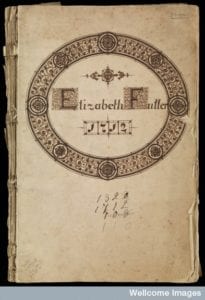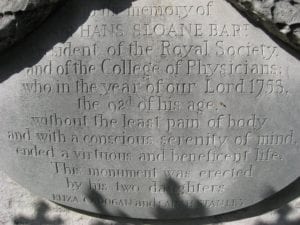A. Anderson to Hans Sloane – August 21, 1731
Item info
Date: August 21, 1731 Author: A. Anderson Recipient: Hans SloaneLibrary: British Library, London Manuscript: Sloane MS 4051 Folio: ff. 310-314
-
Language
English
-
Library
British Library, London
-
Categories
Charity, Legal, Library, Scholarship, Travel
-
Subjects
Amerindians, Books, Christianity, Churches, Colonialism, Dedication, Missionaries, New England, Plantations, Publishing, Religion, Scotland, Slavery, Wills
-
Date (as written)
August 21, 1731
-
Standardised date
-
Origin (as written)
Red Lion Street Clerkenwell
-
Others mentioned
-
Patients mentioned
Original Page
Transcription
[fol. 310] Red Lion Street Clerkenwell, 21. Augt. 1731. Hond Sir In Obedience to your Commands, I herewith send you ye Books & papers relating to ye Society of which you are a Member; I am endeavouring to obtain some Account of ye New-England Society, when I will do my self the Honour to wait on You, or else to send it You. All the World is acquainted with your vertuous & publick-spirited Deeds; the Fame of Which, first encouraged our hon.ble Society to enroll your illustrious name in their Books; and still encourages them to hope for the Continuance of your Favour & Good-Offices. I have the Honour to be with profound Respect Hon:d Sir Your most devoted & most humble servt. A: Anderson [fol. 311] Copy Of a Minute of the General-Meeting of ye Gentlemen associated for executing Mr. D’Allone’s Will; by Instructing ye Negroes of the British Plantations in the Christian Religion: And also for settling parochial Libraries in Great Britain & Ireland; and for establishing a Charitable Colony in America. on ye 12th of August 1731. “Mr Anderson acquainting this Meeting that Sr. Hans Sloane, Bart: was very desireous of any authentick Materials relating to the Attempts which from time to time have been made from hence for converting the heathen & Infidel Parts of the World. Order’d That Mr. Anderson, be desired to wait on Sr Hans Sloane Bart: in the Name of this General Meeting, to acquaint him that they will speedily prepare & present him with a Manuscript Copy of a Work, intended to be published, Giving an Account of the Life of ye late Dr. Thomas Bray, so far as it relates to the many successfull Endeavours of him and others join’d with him, for Propagating the Christian Religion in those Parts: Together with some Account of the Proceedings and Designs of the Gentlemen associated as abovenamed.[“] [fol. 312] For Sr Hans Sloan, Bart. a Minute of ye Associates for Mr D’allone’s Legacy, & for other good purposes; relating to Dr. Bray’s &c. Attempts for Converting the Heathen & Infidel Parts of ye World. [fol. 313] Religious Missions from Scotland. The remote situation of ye Highlands & of ye Northern & Western Islands of Scotland, the barrenness as well as Inaccessibleness of these Parts, and the Slavish Subjection of the Commonalty to the Chieftains of their Clans or Tribes, are the Reasons of the Ignorance & Barbarity of those Parts; For altho’ the Society in Scotland for propagating Christian Knowledge maintain & support above 100 schools among those People yet they have still need of a farther Reformation: That Society may very justly claim the Title of Noble being composed of a great Number of Peers, Gentlemen & Clergy of that Country, & also of several Persons of Distinction & Eminence at & near London: Hitherto they have been forced to bend all their Thoughts to a thorough Reformation of the abovenamed People: Nevertheless, seing their Charter (granted anno 1709.) extends expressly to the Converting of Heathen & Infidel Parts, as well as to their own less cultivated Provinces; They have frequently had it under their Consideration to make some Beginning that Wat: While they had these Thoughts, the Revd. Dr. Daniel Williams an eminent dissenting Clergyman at London, left by his Will, an Estate of about £70 Sterlg. pr. annum to the said Society in Scotland, on Condition that therewith they shall send & maintain three Missionaries to instruct instruct [sic] the Savage Indians of America in the Christian Religion: The Society were extremely glad of this opportunity put into their Hands of doing what they had so earnestly wish’d for: But when they came to compute the Expence, & had established a Correspondence with the Governor & other most Considerable Persons in New-England, it was found that it would require above double the clear Produce of the bequeathed Estate to commence this Mission: This however did not discourage them, for altho’ their annual Expence be every year Increasing by the Augmentation of their Schools, Yet the Society in a General Meeting resolved to go on with this Design: Accordingly having added £60 Sterling. to the Estate, & appointed the Governor, several Counselors & Clergy of New-England for their Correspondents & Commissioners, and it being agreed to send three Divines from the University of Cambridge in New-England, upon the said Mission, to preach the Gospel to the Indians on the Frontiers of that Province; the said Mission is now actually commenced, this year 1731; And as the Inhabitants of New-England are a thriving & sober People, there is Ground to believe that in Time they (as well as Others) will contribute to the Increase & Improvement of a Design already so well begun, & which promises success answerable thereunto. [fol. 314]For S:r Hans Sloan, Bart The Mission of Dr William’s & the Society in Scotland for Propagating Christian Knowledge anno 1731.
A. Anderson was Secretary to the Society for Propagating Christian Knowledge in Scotland.
Patient Details
-
Patient info
Name: N/A
Gender:
Age: -
Description
-
Diagnosis
-
Treatment
Previous Treatment:
Ongoing Treatment:
Response: -
More information
-
Medical problem reference




